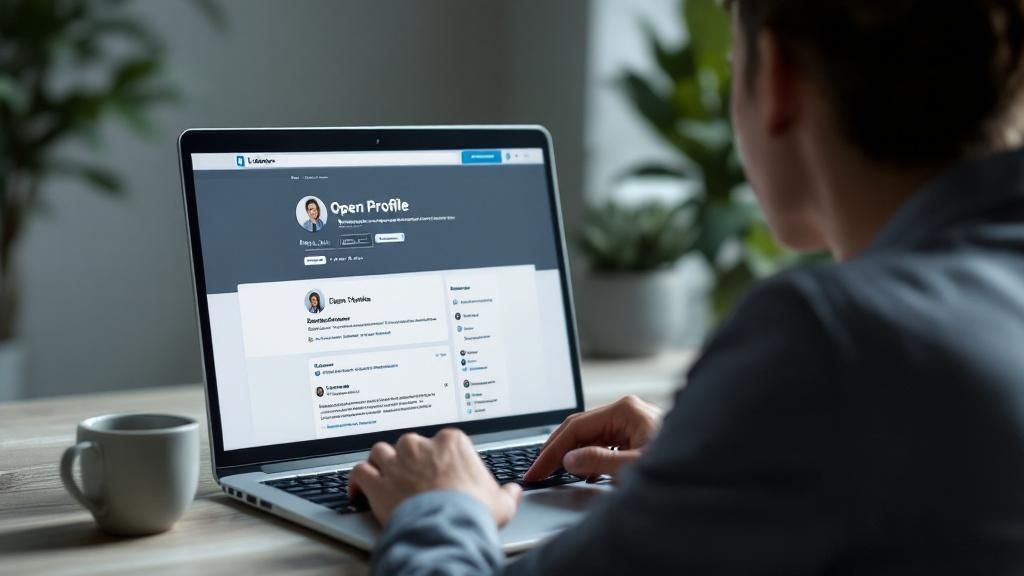Understanding LinkedIn Open Profile: Your Networking Game-Changer

Think of a huge professional conference. Most people will only talk to you if you get a formal introduction. This is how LinkedIn usually works. Now, imagine a few people wearing a "Feel free to chat!" button. That's the idea behind LinkedIn Open Profile. It's a feature that drops the usual communication walls, turning your profile from a simple resume into an invitation for conversation. It tells everyone on the platform that you're open to connecting.
Flipping this single switch can make a big difference. Normally, someone needs to be a mutual connection or use a paid InMail to message you. With Open Profile, anyone on LinkedIn can message you directly at no cost. The feature was designed to make networking smoother by getting rid of the digital "velvet rope" that often separates professionals. By turning it on, you make it much easier for opportunities to come to you. You can find more details on why this matters by looking into some key LinkedIn networking statistics.
The Strategic Advantage of Accessibility
Turning on Open Profile is more than a simple setting change; it's a strategic move. When you make yourself more accessible, you become a more attractive candidate for recruiters and potential partners who are actively looking for people but might be outside your direct network. It smooths out the process for them, making it more likely they will reach out to you instead of someone with a more closed-off profile.
To get the most out of your Open Profile, think of it as one piece of your overall personal brand. Seeing how this feature fits into a bigger career strategy can be very helpful. Checking out an ultimate guide to building your personal brand can show you how to connect all the dots for your professional growth.
How Open Profile Actually Works Behind The Scenes
To understand what LinkedIn Open Profile is, think about standard LinkedIn messaging like sending a letter through the mail. Normally, you need a pre-existing relationship (a 1st-degree connection) or you have to pay for special postage (an InMail credit). Your profile is essentially "unlisted."
Activating Open Profile is like choosing to publish your professional "address" in a public directory. It's a signal to LinkedIn's system that you're welcoming messages, so the usual postage and introduction requirements are waived for your account. When another member wants to message you, LinkedIn’s system checks your profile status. If Open Profile is on, the system bypasses the normal restrictions. This turns what would have been a paid InMail or a blocked message into a free message that lands directly in your primary inbox.
Standard Messaging vs. Open Profile
This simple switch from a closed-off to an open communication channel makes a big difference. It's especially useful for making you more accessible to recruiters, potential partners, and other professionals who might not have a Premium account to send InMails.
To make the differences clear, here’s a breakdown of how messaging works for a standard profile versus one with Open Profile enabled.
LinkedIn Messaging: Standard vs. Open Profile Comparison
| Feature | Standard Profile | Open Profile | Premium Required |
|---|---|---|---|
| Messaging 1st-degree Connections | Unlimited free messages | Unlimited free messages | No |
| Receiving Messages from Non-connections | Blocked unless they use an InMail credit | Any LinkedIn member can send a free message | No (for the receiver) |
| Sending Messages to Non-connections | Requires InMail credits (paid) | Any LinkedIn member can send you a free message | Yes (to send InMails) |
| Profile Message Button Visibility | Visible only to 1st-degree connections and InMail users | Visible and accessible to all LinkedIn members | No |
| Discoverability for Recruiters | Visible, but messaging is restricted | Higher accessibility, appears more often in searches for open candidates | No |
This table shows that the key benefit of Open Profile is removing the barrier for non-connections to contact you, making communication on the platform much more fluid and democratic.
The Impact on Your Visibility
Switching from a closed to an open channel does more than just allow messages; it directly affects how many people see and interact with your profile. The data below shows the typical increases users report after enabling Open Profile.

These numbers demonstrate a clear pattern: removing communication roadblocks doesn't just invite more messages. It significantly boosts your overall profile traffic and encourages more meaningful engagement from relevant professionals in your field.
Why Open Profile Users See Dramatically Better Results

Activating Open Profile does more than just flip a switch in your settings; it sends a strong psychological message to everyone on LinkedIn. Think of it as the digital version of changing your office from a "closed-door" space to one with a welcoming, "open-door" policy. This small adjustment changes how people see your willingness to connect.
This shift removes the usual friction and awkwardness that can come with sending a cold message. When a recruiter or potential partner sees you're open to being contacted, they're much more likely to start a conversation. They see it as responding to an invitation, not as an unwelcome interruption.
The Power of Being Approachable
This newfound approachability leads to real, measurable results. Statistics show that users who signal their availability get a major boost in engagement. For example, members who use features like Open Profile or the #OpenToWork frame receive about 40% more InMails from recruiters.
It's not just about getting more messages, but about attracting better opportunities that you might have otherwise missed. Recruiters on a tight deadline or with a limited number of InMail credits will naturally focus on candidates who are the easiest to reach. You can find more details on how LinkedIn activity boosts your profile's visibility.
Unlocking New Opportunities
The advantages go well beyond just finding a new job. For consultants, freelancers, and sales professionals, an Open Profile works like a 24/7 lead generation machine. It opens the door to inquiries about your services, collaborations, and partnerships from a much larger audience.
Professionals who are actively prospecting on LinkedIn discover that having an Open Profile turns them into a magnet for inbound leads, which perfectly complements their own outreach efforts. It essentially puts your networking on autopilot, making sure you never miss out on a valuable connection due to a simple communication barrier. Your profile goes from being a static resume to a dynamic hub for your career growth.
Setting Up Your Open Profile: A Step-By-Step Guide
Turning on your LinkedIn Open Profile is a quick process, but getting it right is about more than just flipping a switch. Imagine you're opening an exclusive, new entrance to your professional world; you want to make sure the path is clear and leads to the right conversations. The whole setup takes just a few minutes and is your first step toward gaining more attention from recruiters and potential partners.
Finding the Right Settings Menu
First, you'll need to head over to LinkedIn's privacy controls. This is the command center where you manage who sees your activity and how people can get in touch with you.
- Click your “Me” icon, located in the top right corner of the LinkedIn navigation bar.
- Choose “Settings & Privacy” from the menu that appears.
- On the left-hand menu, select the “Visibility” tab.
- Scroll down until you find the “Visibility of your profile & network” section.
This area gives you a clear overview of your current privacy levels and is where you'll find the options to adjust your profile's accessibility.

This screenshot points to the central hub for managing your public presence, including the critical settings for who can message you.
Activating Open Profile Messaging
Once you're in the right spot, enabling the feature is simple. You are essentially giving any LinkedIn member permission to message you directly, which is the core of what a LinkedIn Open Profile is.
- In the “Visibility of your profile & network” options, find and click on “Messages”.
- You'll see an option labeled “Allow others to send you Open Profile messages.”
- Just toggle the switch to “Yes”.
By making this change, you eliminate the need for others to have a connection with you or use an InMail credit to reach out. This small action can dramatically increase the number of opportunities that come your way, especially if you have a proactive outreach plan. If you want to get the most out of your networking, learning more about LinkedIn automation for networking or job prospecting can offer great ideas for managing this new flow of communication.
Your profile is now officially "open." This means the “Message” button on your profile is active for every LinkedIn member, inviting them to start a conversation without any barriers.
Advanced Strategies For Open Profile Success
Turning on your Open Profile is like flipping the "Open" sign on your professional storefront. But just being open for business isn't enough to attract the best customers. You need smart merchandising to draw in high-value visitors and turn that increased visibility into real career opportunities.
Think of your profile as a compelling window display. Your headline, summary, and featured sections must work together to tell a clear story about who you are and the value you bring. This encourages the right people—recruiters, clients, or partners—to step inside for a conversation. This is the core purpose of what a LinkedIn Open Profile is: it’s not just about getting more messages, but about getting the right ones.
Develop a Resonant Personal Brand
Your profile needs to communicate your personal brand almost instantly. What are the top three skills or qualities you want a recruiter to see first? Make sure these are prominent in your headline and the very first lines of your "About" section.
To support your brand, regularly share content that reinforces your expertise. To truly stand out, you can use specialized tools for crafting impactful LinkedIn posts that help you write compelling updates and establish your thought leadership. Consistent, high-value content amplifies your profile’s reach and builds your credibility with every post.
Tailor Your Approach to Your Career Stage
Your strategy for using an Open Profile should change as your career evolves. A recent graduate has very different goals than a seasoned executive, and your profile should reflect that. An entry-level professional is focused on gaining experience, while a senior leader is more interested in building strategic partnerships.
To help you align your profile with your professional goals, here is a breakdown of how to adjust your strategy based on where you are in your career.
Open Profile Optimization Strategies by Career Level
Tailored strategies and best practices for maximizing Open Profile effectiveness based on different career stages and professional goals
| Career Stage | Primary Benefits | Key Strategies | Success Metrics |
|---|---|---|---|
| Entry-Level | Gaining experience and building initial connections. | Emphasize transferable skills, relevant coursework, certifications, and a strong enthusiasm for learning. Showcase projects and volunteer work. | An increase in connection requests from recruiters and professionals in your target industry. Invitations to informational interviews. |
| Mid-Career | Securing leadership roles or transitioning into new industries. | Showcase achievements with quantifiable results (e.g., "Increased sales by 25%"). Share industry insights and articles to demonstrate expertise. | A rise in unsolicited messages from senior recruiters and hiring managers. More views on your profile from people at target companies. |
| Senior/Executive | Building thought leadership and finding strategic partnerships. | Highlight your leadership philosophy, industry impact, and strategic vision. Focus on board positions, speaking engagements, and major projects. | Invitations to speak at industry events, partnership proposals, and high-level networking opportunities with other executives. |
By fine-tuning your profile based on your career stage, you transform your Open Profile from a simple "on" switch into a strategic tool. This targeted approach ensures the visibility you gain leads to the specific opportunities you're looking for.
Common Open Profile Mistakes and How to Avoid Them
Activating your LinkedIn Open Profile can feel like opening the floodgates to new opportunities. However, it requires some strategic management to avoid common errors. Think of it like hosting an open house for your career; you want to attract qualified, interested parties, not just casual browsers who waste your time. If you mismanage this feature, a professional asset can quickly become a source of frustration.
One of the most common mistakes is failing to update the rest of your profile. Simply flipping the "Open Profile" switch without polishing your headline and summary is a huge missed opportunity. Your profile must clearly communicate who you are and what value you provide. If it's too general, you'll be buried under a mountain of irrelevant messages. A vague profile attracts vague inquiries, which is a recipe for wasted effort.
Navigating the Influx of Messages
Another major misstep is not having a game plan for the increased message volume. Without a clear strategy, important conversations can easily slip through the cracks.
Here’s how to stay in control:
- Set Realistic Response Expectations: You are not obligated to reply to every single message, especially clear spam. Your focus should be on engaging with inquiries that genuinely align with your professional goals. It’s about quality, not quantity.
- Maintain Professional Etiquette: Sending a generic, copy-and-pasted response can do more harm than good to your professional brand. A brief, personalized reply shows respect. Acknowledging a relevant message, even to politely decline an offer, helps maintain positive connections.
- Watch for Warning Signs: If most of your new messages are off-topic or from completely unrelated industries, it’s a red flag. This signals that your profile's messaging is too broad. Take this as your cue to revisit and sharpen your headline and summary to be more specific about your expertise and what you're looking for.
By proactively managing your profile and your communication, you can sidestep these common pitfalls. This approach ensures your Open Profile functions as intended—a powerful tool for building meaningful connections, not just a magnet for digital noise. You can learn more about how to convert these connections into tangible results by exploring tips on improving your LinkedIn sales close rate.
Your Action Plan for Open Profile Success
Knowing what a LinkedIn Open Profile is and actually using it to your advantage are two different things. Turning on the "open" sign is just the first step. Real success comes from creating a clear, actionable plan to grow your professional presence. This is about actively guiding your career story, not just waiting for opportunities to find you.
Think of your plan as a road map with specific, measurable goals. You'll start with a simple checklist to get your profile ready for new visitors. After that, you'll put specific networking strategies into motion that align with your career ambitions.
Profile Optimization Checklist
Before you begin reaching out to people, you need to be sure your profile is sending the right message. A well-optimized profile is like your personal salesperson, working for you around the clock.
- Headline: Is it catchy and filled with relevant keywords? It should immediately tell visitors who you are and what you offer.
- Summary: Does your "About" section share an engaging story about your professional path and the value you bring?
- Featured Section: Have you highlighted your best work? This could include projects, articles, or presentations that showcase your skills.
- Skills & Endorsements: Are your top 5 skills directly related to your career goals? Have they been endorsed by your connections?
Long-Term Relationship Building
Lasting career growth isn't about collecting contacts; it's about building genuine professional relationships. Set a practical timeline for your networking. A good starting point is aiming to connect with 5-10 new, relevant professionals each week.
Don't stop at just sending a connection request. Always follow up with a personalized message. The idea is to move past the initial handshake and build a solid foundation for long-term professional partnerships. This hands-on approach will turn your Open Profile into a powerful tool for consistent career advancement.
Ready to automate and expand your outreach efforts while keeping that personal touch? Discover how Salesloop.io can supercharge your networking strategy today!





